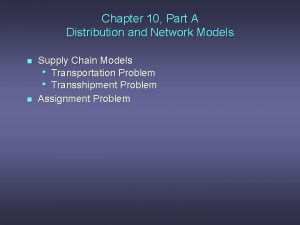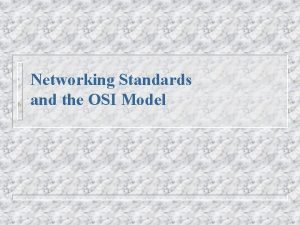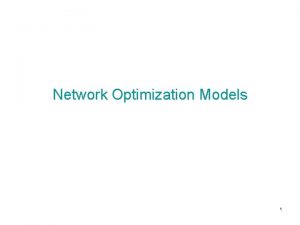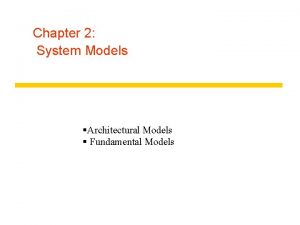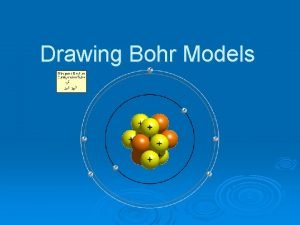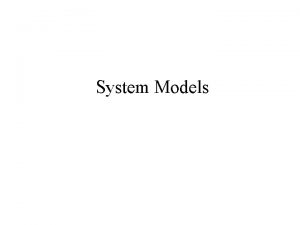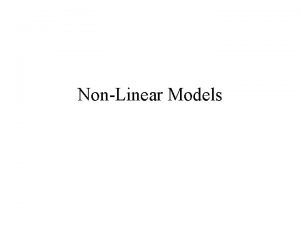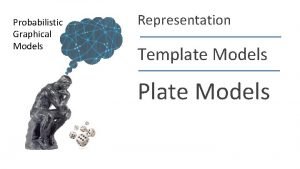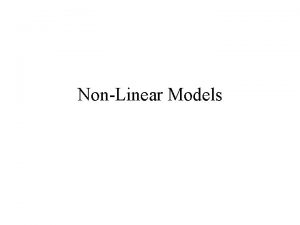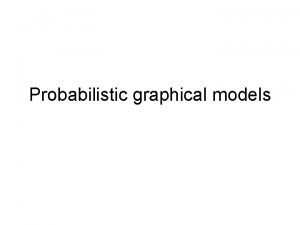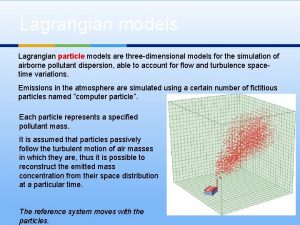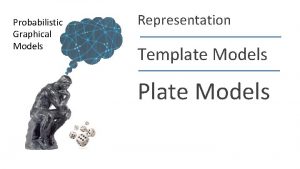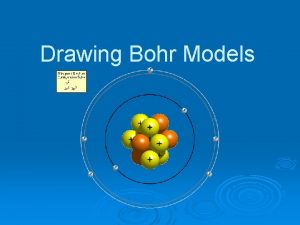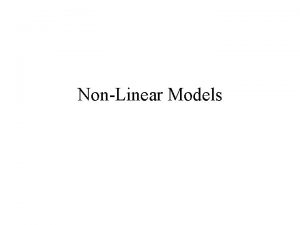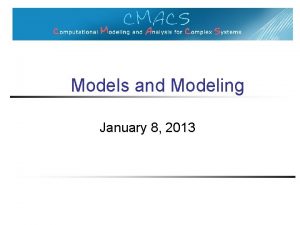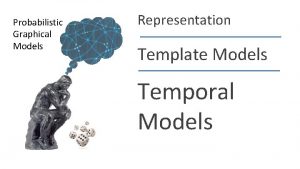Chapter 2 Network Models 2 1 Copyright The











































- Slides: 43

Chapter 2 Network Models 2. 1 Copyright © The Mc. Graw-Hill Companies, Inc. Permission required for reproduction or display.

2 -1 LAYERED TASKS We use the concept of layers in our daily life. As an example, let us consider two friends who communicate through postal mail. The process of sending a letter to a friend would be complex if there were no services available from the post office. Topics discussed in this section: Sender, Receiver, and Carrier Hierarchy 2. 2

Figure 2. 1 2. 3 Tasks involved in sending a letter

2 -2 THE OSI MODEL Established in 1947, the International Standards Organization (ISO) is a multinational body dedicated to worldwide agreement on international standards. An ISO standard that covers all aspects of network communications is the Open Systems Interconnection (OSI) model. It was first introduced in the late 1970 s. Topics discussed in this section: Layered Architecture Peer-to-Peer Processes Encapsulation 2. 4

Note ISO is the organization. OSI is the model. 2. 5

Figure 2. 2 Seven layers of the OSI model • Connect software to the network • Mainly software • Link the 2 groups • deal with physical aspects of moving data • software and hardware Each layer define a part of the process of moving information 2. 6

In developing the model, q The designers distilled the process of transmitting data to its most fundamental elements. q They identified which networking functions had related uses and collected those functions into discrete groups that became the layers. q Each layer defines a family of functions distinct from those of the other layers. q. In this way, ØOSI is both comprehensive and flexible. Ø OSI model allows complete interoperability 2. 7

Figure 2. 3 The interaction between layers in the OSI model • In receiving, each layer serves the successor layer and being served by the predecessor • Interference defines the functions and information provided to the layer above • layers on the side of A communicate with B (peer to peer protocol) • routers only have layers 1, 2 and 3 2. 8

Figure 2. 4 An exchange using the OSI model header trailer Encapsulation: packet and header N-1 encapsulates the whole packets at N 2. 9

2 -3 LAYERS IN THE OSI MODEL In this section we briefly describe the functions of each layer in the OSI model. Topics discussed in this section: Physical Layer Data Link Layer Network Layer Transport Layer Session Layer Presentation Layer Application Layer 2. 10

Figure 2. 5 Physical layer 2. 11

The physical layer is responsible for movements of individual bits from one hop (node) to the next. It also responsible for: • Physical characteristics of interfaces and medium • Representation of bits • Synchronization • Physical Topology 2. 12

Figure 2. 6 Data link layer 2. 13

The data link layer is responsible for moving frames from one hop (node) to the next. It also responsible for • Framing • Physical addressing for devices on the same network • Flow control to avoided receiver overwhelming • Error Control- trailer • Access Control to determine which device has control over the link 2. 14

Figure 2. 7 Hop-to-hop delivery 2. 15

Figure 2. 8 Network layer 2. 16

The network layer is responsible for the delivery of individual packets from the source host to the destination host. It also responsible for: • Logical addressing for destination outside the network • Routing-> making decision based on the destination 2. 17

Figure 2. 9 Source-to-destination delivery 2. 18

Figure 2. 10 Transport layer 2. 19

The transport layer is responsible for the delivery of the “whole” message from one device to another. It also responsible for: • service point addressing => making sure process delivery • segmentation and reassembly => • connection control => connection/connection less • flow control • Error control 2. 20

Figure 2. 11 Reliable process-to-process delivery of a message 2. 21

Figure 2. 12 Session layer 2. 22

Note The session layer is responsible for: • Dialog control between 2 processes • Synchronization => add check points 2. 23

Figure 2. 13 Presentation layer 2. 24

The presentation layer is responsible for: • Translation => interoperability between different encoding system • Compression • encryption. 2. 25

Figure 2. 14 Application layer 2. 26

The application layer is responsible for providing services to the user. • File transfer, access and management • Mail services 2. 27

Figure 2. 15 Summary of layers 2. 28

2 -4 TCP/IP PROTOCOL SUITE The layers in the TCP/IP protocol suite do not exactly match those in the OSI model. The original TCP/IP protocol suite was defined as having four layers: host-tonetwork, internet, transport, and application. However, when TCP/IP is compared to OSI, we can say that the TCP/IP protocol suite is made of five layers: physical, data link, network, transport, and application. Topics discussed in this section: Physical and Data Link Layers Network Layer Transport Layer Application Layer 2. 29

Figure 2. 16 TCP/IP and OSI model 2. 30

2 -5 ADDRESSING Four levels of addresses are used in an internet employing the TCP/IP protocols: physical, logical, port, and specific. Topics discussed in this section: Physical Addresses Logical Addresses Port Addresses Specific Addresses 2. 31

Figure 2. 17 Addresses in TCP/IP 2. 32

Figure 2. 18 Relationship of layers and addresses in TCP/IP 2. 33

Example 2. 1 In Figure 2. 19 a node with physical address 10 sends a frame to a node with physical address 87. The two nodes are connected by a link (bus topology LAN). As the figure shows, the computer with physical address 10 is the sender, and the computer with physical address 87 is the receiver. 2. 34

Figure 2. 19 Physical addresses 2. 35

Example 2. 2 As we will see in Chapter 13, most local-area networks use a 48 -bit (6 -byte) physical address written as 12 hexadecimal digits; every byte (2 hexadecimal digits) is separated by a colon, as shown below: 07: 01: 02: 01: 2 C: 4 B A 6 -byte (12 hexadecimal digits) physical address. 2. 36

Example 2. 3 Figure 2. 20 shows a part of an internet with two routers connecting three LANs. Each device (computer or router) has a pair of addresses (logical and physical) for each connection. In this case, each computer is connected to only one link and therefore has only one pair of addresses. Each router, however, is connected to three networks (only two are shown in the figure). So each router has three pairs of addresses, one for each connection. 2. 37

Figure 2. 20 IP addresses 2. 38

Example 2. 4 Figure 2. 21 shows two computers communicating via the Internet. The sending computer is running three processes at this time with port addresses a, b, and c. The receiving computer is running two processes at this time with port addresses j and k. Process a in the sending computer needs to communicate with process j in the receiving computer. Note that although physical addresses change from hop to hop, logical and port addresses remain the same from the source to destination. 2. 39

Figure 2. 21 Port addresses 2. 40

Note The physical addresses will change from hop to hop, but the logical addresses usually remain the same. 2. 41

Example 2. 5 As we will see in Chapter 23, a port address is a 16 -bit address represented by one decimal number as shown. 753 A 16 -bit port address represented as one single number. 2. 42

Note The physical addresses change from hop to hop, but the logical and port addresses usually remain the same. 2. 43
 Modal and semi modal verbs
Modal and semi modal verbs Distribution and network models
Distribution and network models Iso networking standards
Iso networking standards Layered tasks
Layered tasks Hát kết hợp bộ gõ cơ thể
Hát kết hợp bộ gõ cơ thể Frameset trong html5
Frameset trong html5 Bổ thể
Bổ thể Tỉ lệ cơ thể trẻ em
Tỉ lệ cơ thể trẻ em Chó sói
Chó sói Tư thế worm breton là gì
Tư thế worm breton là gì Hát lên người ơi
Hát lên người ơi Các môn thể thao bắt đầu bằng từ đua
Các môn thể thao bắt đầu bằng từ đua Thế nào là hệ số cao nhất
Thế nào là hệ số cao nhất Các châu lục và đại dương trên thế giới
Các châu lục và đại dương trên thế giới Công của trọng lực
Công của trọng lực Trời xanh đây là của chúng ta thể thơ
Trời xanh đây là của chúng ta thể thơ Mật thư anh em như thể tay chân
Mật thư anh em như thể tay chân Làm thế nào để 102-1=99
Làm thế nào để 102-1=99 độ dài liên kết
độ dài liên kết Các châu lục và đại dương trên thế giới
Các châu lục và đại dương trên thế giới Thể thơ truyền thống
Thể thơ truyền thống Quá trình desamine hóa có thể tạo ra
Quá trình desamine hóa có thể tạo ra Một số thể thơ truyền thống
Một số thể thơ truyền thống Cái miệng bé xinh thế chỉ nói điều hay thôi
Cái miệng bé xinh thế chỉ nói điều hay thôi Vẽ hình chiếu vuông góc của vật thể sau
Vẽ hình chiếu vuông góc của vật thể sau Biện pháp chống mỏi cơ
Biện pháp chống mỏi cơ đặc điểm cơ thể của người tối cổ
đặc điểm cơ thể của người tối cổ Giọng cùng tên là
Giọng cùng tên là Vẽ hình chiếu đứng bằng cạnh của vật thể
Vẽ hình chiếu đứng bằng cạnh của vật thể Vẽ hình chiếu vuông góc của vật thể sau
Vẽ hình chiếu vuông góc của vật thể sau Thẻ vin
Thẻ vin đại từ thay thế
đại từ thay thế điện thế nghỉ
điện thế nghỉ Tư thế ngồi viết
Tư thế ngồi viết Diễn thế sinh thái là
Diễn thế sinh thái là Dot
Dot So nguyen to
So nguyen to Tư thế ngồi viết
Tư thế ngồi viết Lời thề hippocrates
Lời thề hippocrates Thiếu nhi thế giới liên hoan
Thiếu nhi thế giới liên hoan ưu thế lai là gì
ưu thế lai là gì Khi nào hổ mẹ dạy hổ con săn mồi
Khi nào hổ mẹ dạy hổ con săn mồi Sự nuôi và dạy con của hươu
Sự nuôi và dạy con của hươu Hệ hô hấp
Hệ hô hấp

